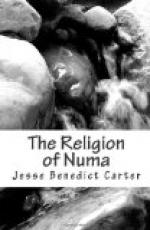deities of Rome with the new foreign gods, calling
the former the “old indigenous gods” (
Di
Indigetes) and the latter the “newly settled
gods” (
Di Novensides). For our knowledge
of the religion of this period we are not dependent
upon a mere theory, no matter how good it may be in
itself, but we have the best sort of contemporary
evidence in addition, and it is to the discovery of
this evidence that the modern study of Roman religion
virtually owes its existence. The records of
early political history were largely destroyed in
B.C. 390 when the Gauls sacked Rome, but the religious
status, with the conservativeness characteristic of
religion generally, suffered very few changes during
all these years, and left a record of itself in the
annually recurring festivals of the Roman year, festivals
which grew into an instinctive function of the life
of the common people. Many centuries later when
the calendar was engraved on stone, these revered
old festivals were inscribed on these stone calendars
in peculiarly large letters as distinguished from
all the other items. Thus from the fragments
of these stone calendars, which have been found, and
which are themselves nineteen centuries old, we can
read back another eight or ten centuries further.
By the aid of this “calendar of Numa” we
are able to assert the presence of certain deities
in the Rome of this time, and the equally important
absence of others. And from the character of
the deities present and of the festivals themselves
a correct and more or less detailed picture of the
religious condition of the time may be drawn.
This calendar and the list of
Indigetes extracted
from it form the foundation for all our study of the
history of Roman religion.
The religious forms of a community are always so bound
up with its social organisation that a satisfactory
knowledge of the one is practically impossible without
some knowledge of the other. Unfortunately there
is no field in Roman history where theories are so
abundant and facts so rare as in regard to the question
of the early social organisation. But without
coming into conflict with any of the rival theories
we may make at least the following statements.
In the main the community was fairly uniform and homogeneous,
there were no great social extremes and no conspicuous
foreign element, so that each individual, had he stopped
to analyse his social position, would have found himself
in four distinct relationships: a relationship
to himself as an individual; to his family; to the
group of families which formed his clan (gens);
and finally to the state. We may go a step further
on safe ground and assert that the least important
of these relations was that to himself, and the most
important that to his family. The unit of early
Roman social life was not the individual but the family,
and in the most primitive ideas of life after death
it is the family which has immortality, not the individual.
The state is not a union of individuals but of families.




